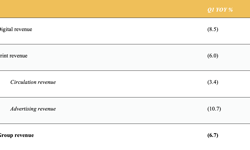In another tough year for online businesses, “the economy” returned to the top of the list identified by members of the Association of Online Publishers (AOP) in the annual Census, as one of the biggest threats to their businesses this year. While the opportunities identified, with near majority ratings, were: iPad / other tablets; adoption of smartphones and mobile web. This theme was followed through, as mobile and apps continue to be seen as the biggest trend of the next twelve months, whilst, one in five publishers see the opportunity for digital editions via iPad and other tablets as the most significant trend.
The Census acts as a temperature check of the digital publishing landscape by reflecting the level of current activities being undertaken, the expected degrees of change over the next twelve months and captures sentiment around the issues of most prominence either as an opportunity or threat.
Key themes
There are two main themes to the Census results this year, firstly the growing emphasis on mobile devices and the significant focus on opportunities for publishing via smartphone and tablets, as publishers move to become increasingly platform agnostic with their output. The second key theme is around the growing importance of data to publishers, an area that all are actively involved in developing, with many currently in a period of learning and experimentation. It was clear this year, that underpinned by commercial drivers, publishers plan to utilise their data better, and provide multi-media content access to help develop new revenue streams.
Mobile
In recent years, we’ve seen the sentiment for opportunities for mobile publishing increasing in prominence. Last year, the introduction of the iPad was a significant catalyst and that drove publishers to suggest that it would be the most significant trend of the last twelve months. To some degree, that has been borne out as publishers have embraced the platform for content, particularly trialling paid content, a move that two thirds of all publishers surveyed have taken over the last twelve months, and that’s likely to rise to around eight out of ten publishers over the next twelve months.
Most publishers believe that the opportunity to drive revenues from content is more likely to come from other platforms such as apps or digital editions whilst the core website stays free. When it comes to revenue generation, the strongest view, by more than four in ten publishers, is that iPad / tablet apps and digital editions offer the best platform for paid content opportunities, ahead of core websites. The challenge for publishers now is to deliver to Android devices as well as Apple, as the proliferation of alternatives to iPad takes shape. Having said that, iPad undoubtedly dominates the tablet market but we have seen Apple overtaken in the smartphone market by the emergence of Android and there are not many publishers who don’t recognise the need to make their content available to consumers where and when they want it, which of course pushes publishers into adopting a platform agnostic approach.
Earlier in the year, we saw in the Organisation Census that CMS and API changes were singled out as the top challenge to development for digital publishers. Feeding off the CMS that’s already in place for the web is key to limiting the pressure on editorial and other teams, but it’s still a stretch on resources, apps are time consuming to deliver and there are implications on how workflows are developed. Additionally, editorial teams have to do content provision planning with outside developers or internal apps units, and project teams are needed internally to plan and link all elements to delivery. According to the Content and Trends Census though, publishers are predicting that over the next twelve months, they will be as likely to have apps for both Apple and Android operating systems.
The priority platform for content delivery over the next twelve months is iPad / tablet / digital editions for nine out of ten publishers and two thirds would also rate mobile web and smartphone apps as priority platforms. Almost every publisher now sees iPad and other tablets as representing opportunity for the next twelve months but the adoption of smartphones, whilst just behind in overall terms, actually has a stronger sentiment amongst publishers in terms of being seen as a “major opportunity”. Aligned to this, the most significant trend recognised for the next twelve months is around mobile internet development and mobile apps rather than specifically led by tablets. Around two thirds of publishers believe that mobile devices will become more important than traditional sites, and the great majority will continue to increase substantially their output of specific mobile content or content for apps.
To put it into perspective, around eight out of ten publishers have websites created specifically for mobile viewing and almost nine out of ten publishers have optimised their websites to enable a better user experience from mobile devices. These high rates position the publishing industry well ahead of the curve in comparison to other sectors of UK industry in creating enhanced access to web content via mobile devices.
As an aside, eReader subscriptions are currently generating revenue for just under half of all publishers and tipped to increase to two thirds in twelve months’ time.
Data
Much is being made of the need for publishers to get better at managing data in their businesses. The term “data is the new oil” is becoming a well-worn phrase, and the sentiment that, just like oil, it needs to be refined to maximise its value is the topical analogy. Publishers certainly wouldn’t disagree with that but most acknowledge that they are in a period of learning and experimentation when it comes to data management. B2B publishers have been leading proponents of developing data as an asset whilst B2C publishers have generally lagged some way behind.
But all that is changing as publishers are making moves to align data from the many disparate sources within their businesses, sensing an opportunity but acknowledging that it is in its infancy. The opportunity of course is all around tailored and targeted products and services but currently almost nine out of ten publishers believe that they are under-utilising their data assets. Certainly the nirvana of achieving a single customer view within their business is a long way off yet for the great majority.
Nevertheless, the Census suggests that publishers are taking data much more seriously and one in two publishers are suggesting that they will either apply registration requirements to more sites within their portfolio or deepen the level of registration data required to build more significant profiles of users. Publishers are utilising a proliferation of paid content models; which inevitably require the capture of user data via either registration or subscription. Two thirds of publishers have suggested that they’ll continue to provide free access to content and look to develop revenues based on user data.
As interest in data develops, though, the threat of regulation via government, and legal restrictions, and in particular the EU Privacy Directive, are seen to be the major threats the industry faces, with the only bigger threat being the economy.
Other highlights – Video and Social Media
Video is now ubiquitous, with all publishers carrying video content, two thirds of whom have increased that content year on year, and eight out of ten are creating content through in-house production. Three quarters will increase investment in video over the next twelve months. One in two publishers see video primarily as providing an incremental revenue stream; that’s ahead of additional engagement, visitor retention and stickiness, all key reasons to publish but secondary to the opportunity to drive additional revenue.
A relationship with social media is universally agreed to be important for publishers, and in fact for 60%, it’s “essential”. Eight out of ten publishers will apply funding to brand presence on social networks in the next year with 90% of those funding a presence on Twitter and Facebook, and just under two thirds on YouTube. In terms of importance though, social bridging (or content sharing - ie use of Facebook “Like”, retweeting etc) is considered higher than funding a brand presence. Nine out of ten publishers see the biggest potential driver of audience growth as social bridging, whilst actual brand presence on social networks is seen as both an additional key driver of audience growth (66%) and brand affinity (71%). Three quarters of publishers now have a social media policy and strategy is defined by a specialist social media role in a third of companies.
Finally, what are the other key sentiments publishers feel about the digital publishing landscape? Well, despite the positive belief in the ability to charge for content, triggered especially by the arrival of iPad and other tablets, there’s an overwhelming view shared by over eight out of ten publishers that advertising will dominate revenue generation for some time yet. That’s not to say that publishers are playing down the content revenues opportunity as over one in two publishers believe that consumers will accept that paying for some content online is inevitable and there’s a mixed view on whether paywall models will become more widespread with a third agreeing, a third disagreeing and another third undecided.
So, expect publishers to establish deeper connections with audiences over the coming year and expect your connections with publishing brands to become increasingly versatile as devices proliferate.
The Association of Online Publishers launched its annual survey of AOP members’ businesses in 2002; and this is the third year that the Census has been split into an ‘Organisation’ survey published in the spring, and a ‘Content & Trends’ survey published in the autumn.
AOP members include newspaper and magazine publishing, TV and radio broadcasting and pure online media representing 1500 respected brands and publications producing original, branded, premium and quality content.










